 Backend Development
Backend Development PHP Tutorial
PHP Tutorial Yii Framework Official Guide Series 46 - Special Topic: Error Handling
Yii Framework Official Guide Series 46 - Special Topic: Error HandlingYii provides a complete error handling mechanism based on PHP5 exception handling. When an application starts running and handles user requests, the handleError method is registered to handle PHP warnings and notices information; the handleException method is also registered to handle uncaught PHP exceptions. Therefore, if a PHP warning/notice or an uncaught PHP exception occurs while the application is running, the error handler will take over control and run the necessary handling mechanisms.
Tips: The error handler is registered in the constructor method of the application, using the PHP functions set_exception_handler and set_error_handler. If you don't want Yii to handle errors and exceptions, you can define
YII_ENABLE_ERROR_HANDLERandYII_ENABLE_EXCEPTION_HANDLERas false in the entry file.
By default, in When the onError event (or onException event) is triggered, the errorHandler (or exceptionHandler) will be triggered. If the error or exception is not handled by any event, then you need to run the errorHandler component to handle it.
1. Raising exceptions
Raising exceptions in Yii is no different from ordinary PHP files. You can use the following code to throw an exception:
throw new ExceptionClass('错误信息');
Yii defines two exception classes: CException and CHttpException . The former is a general exception class, while the latter is used to display exception information to end users. At the same time, the latter has a statusCode attribute to represent the HTTP status code. The type of exception determines the display effect, which will be discussed in detail below.
Tips: If you want to tell the user that a certain operation is wrong, throwing a CHttpException is the easiest way. For example, if the user provides an invalid ID value in the URL, we can display a 404 error:
// 如果提交的ID是无效的 throw new CHttpException(404,'此页面不存在');
2. Display errors
When an error is forwarded to the component CErrorHandler, it will select the appropriate view to display the error. If the error is to be displayed to the end user (for example, a CHttpException) then a view named errorXXX will be used to display the error. This XXX represents the HTTP error code (such as 400, 404, 500, etc.). If this is an internal error that should only be visible to developers, the view name that will be used is exception. In the latter case, the complete call stack information and error line information will be displayed.
Information: When the application is running in production mode, all errors, including internal errors, will use view
errorXXX. This is because the call stack information and error line information may contain some sensitive information. In this case, developers should rely on error logs to determine the cause of the error.
CErrorHandler will search for the appropriate view to display the error message. The search order is as follows:
##WebRoot/themes/ThemeName/views/system
: In thesystemdirectory under the current theme view.WebRoot/protected/views/system
: In thesystemdirectory of the application's default view.yii/framework/views
: In the standard view directory provided by Yii.
system view directory or the theme's system view directory A view file. Each view file is a regular PHP file containing a lot of HTML code. Refer to the files in the view directory of the framework for more information.
return array( ...... 'components'=>array( 'errorHandler'=>array( 'errorAction'=>'site/error', ), ), );In the above code, we configured the CErrorHandler::errorAction attribute, and the attribute value is a route
site/error. This route points to error in SiteController. Of course, you can also use other routes.
error action like this:
public function actionError()
{
if($error=Yii::app()->errorHandler->error)
$this->render('error', $error);
}
In this In the action, detailed error information is first obtained from CErrorHandler::error. If the obtained information is not empty, use the information returned by CErrorHandler::error to render the error view. The information returned by CErrorHandler::error is an array with the following structure:
-
code
: HTTP status code (such as 403, 500); type
: Error type (such as CHttpException,PHP Error);message
: Error message;file
: The name of the PHP file where the error occurred;line
: The line where the error is located;trace
: Error call stack information;source
: The context of the code where the error occurred.
Tip: The reason why we check whether CErrorHandler::error is empty is that the
erroraction can be accessed by the user. At this time, it may not be possible. Nothing wrong. When we pass the$errorarray to the view, it will be automatically released as an independent variable. Therefore, in the view we can use$code,$typeto access this information.
4. Message recording
An error level error message will be recorded when an error occurs. If the error is caused by a PHP warning or notice, the message will be logged in the php category; if the error message is caused by an uncaught exception, the category will be exception.ExceptionClassName (For CHttpException, its statusCode will also be appended to the class name). Developers can use these records to monitor error messages during application execution
The above is Yii Framework Official Guide Series 46 - Special Topic: Error Handling. For more related content, please pay attention to the PHP Chinese website (www.php .cn)!
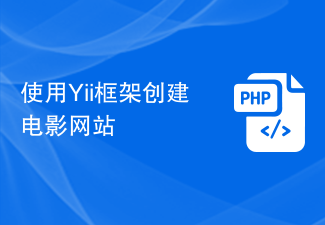 使用Yii框架创建电影网站Jun 21, 2023 am 09:04 AM
使用Yii框架创建电影网站Jun 21, 2023 am 09:04 AM随着互联网的普及以及人们对电影的热爱,电影网站成为了一个受欢迎的网站类型。在创建一个电影网站时,一个好的框架是非常必要的。Yii框架是一个高性能的PHP框架,易于使用且具有出色的性能。在本文中,我们将探讨如何使用Yii框架创建一个电影网站。安装Yii框架在使用Yii框架之前,需要先安装框架。安装Yii框架非常简单,只需要在终端执行以下命令:composer
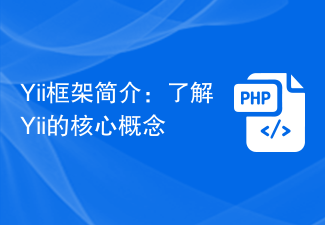 Yii框架简介:了解Yii的核心概念Jun 21, 2023 am 09:39 AM
Yii框架简介:了解Yii的核心概念Jun 21, 2023 am 09:39 AMYii框架是一个高性能、高扩展性、高可维护性的PHP开发框架,在开发Web应用程序时具有很高的效率和可靠性。Yii框架的主要优点在于其独特的特性和开发方法,同时还集成了许多实用的工具和功能。Yii框架的核心概念MVC模式Yii采用了MVC(Model-View-Controller)模式,是一种将应用程序分为三个独立部分的模式,即业务逻辑处理模型、用户界面呈
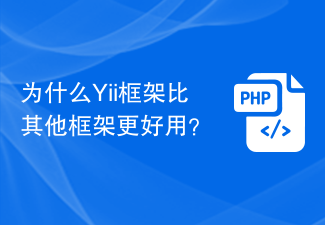 为什么Yii框架比其他框架更好用?Jun 21, 2023 am 10:30 AM
为什么Yii框架比其他框架更好用?Jun 21, 2023 am 10:30 AMYii框架是一个高性能、可扩展、安全的PHP框架。它是一个优秀的开发工具,能够让开发者快速高效地构建复杂的Web应用程序。以下是几个原因,让Yii框架比其他框架更好用。高性能Yii框架使用了一些先进的技术,例如,延迟加载(lazyloading)和自动加载机制(automaticclassloading),这使得Yii框架的性能高于许多其他框架。它还提
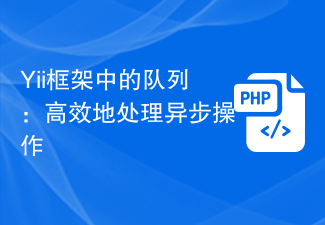 Yii框架中的队列:高效地处理异步操作Jun 21, 2023 am 10:13 AM
Yii框架中的队列:高效地处理异步操作Jun 21, 2023 am 10:13 AM随着互联网的快速发展,应用程序对于处理大量并发请求和任务变得越来越重要。在这样的情况下,处理异步任务是必不可少的,因为这可以使应用程序更加高效,并更好地响应用户请求。Yii框架提供了一个方便的队列组件,使得处理异步操作更加容易和高效。在本篇文章中,我们将探讨Yii框架中队列的使用和优势。什么是队列队列是一种数据结构,用于处理数据的先进先出(FIFO)顺序。队
 Yii框架中的ViewState:实现数据保护Jun 21, 2023 am 09:02 AM
Yii框架中的ViewState:实现数据保护Jun 21, 2023 am 09:02 AMViewState是ASP.NET中的一种机制,用于保护页面的隐私数据。而在Yii框架中,ViewState同样也是实现页面数据保护的重要手段。在Web开发中,随着用户界面操作的复杂度增加,前端与后端之间的数据传输也愈发频繁。但是,不可避免的会有恶意用户通过网络抓包等手段截获数据。而未加保护的数据可能含有用户隐私、订单信息、财务数据等重要资料。因此,加密传输
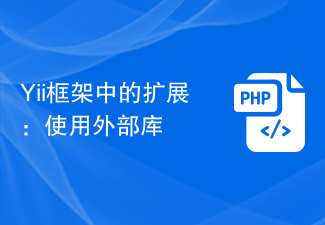 Yii框架中的扩展:使用外部库Jun 21, 2023 am 10:11 AM
Yii框架中的扩展:使用外部库Jun 21, 2023 am 10:11 AMYii是一款优秀的PHP框架,它提供了很多丰富的功能和组件来加快Web应用程序的开发。其中一个非常重要的特性就是可以方便地使用外部库进行扩展。Yii框架中的扩展可以帮助我们快速完成许多常见的任务,例如操作数据库、缓存数据、发送邮件、验证表单等等。但是有时候,我们需要使用一些其他的PHP类库来完成特定的任务,例如调用第三方API、处理图片、生成PDF文件等等。
 Yii框架中的分页机制:优化数据展示效果Jun 21, 2023 am 08:43 AM
Yii框架中的分页机制:优化数据展示效果Jun 21, 2023 am 08:43 AM在现今互联网时代,数据的处理和展示对于各种应用而言都是至关重要的。对于一些数据量较大的网站,其展示效果直接影响用户体验,而优秀的分页机制可以使得数据展示更加清晰,提高用户的使用体验。在本文中,我们将介绍Yii框架中的分页机制,并探讨如何通过优化分页机制来改进数据展示效果。Yii框架是一种基于PHP语言的高性能、适用于Web应用的开发框架。它提供
 Yii框架中的ORM:简化数据库操作Jun 21, 2023 am 08:19 AM
Yii框架中的ORM:简化数据库操作Jun 21, 2023 am 08:19 AMYii框架是一款快速、高效、安全的PHP开发框架,依托于丰富的工具和组件,Yii框架可以帮助开发者更轻松地构建高质量的Web应用程序。其中,ORM(对象关系映射)是Yii框架其中之一的特点。这篇文章将简单介绍Yii框架中的ORM,并说明其如何简化数据库操作。一、什么是ORMORM是指对象关系映射,它将面向对象的编程语言中的对象与关系型数据库中的表进行映射,使


Hot AI Tools

Undresser.AI Undress
AI-powered app for creating realistic nude photos

AI Clothes Remover
Online AI tool for removing clothes from photos.

Undress AI Tool
Undress images for free

Clothoff.io
AI clothes remover

AI Hentai Generator
Generate AI Hentai for free.

Hot Article

Hot Tools

Atom editor mac version download
The most popular open source editor

VSCode Windows 64-bit Download
A free and powerful IDE editor launched by Microsoft

MinGW - Minimalist GNU for Windows
This project is in the process of being migrated to osdn.net/projects/mingw, you can continue to follow us there. MinGW: A native Windows port of the GNU Compiler Collection (GCC), freely distributable import libraries and header files for building native Windows applications; includes extensions to the MSVC runtime to support C99 functionality. All MinGW software can run on 64-bit Windows platforms.

SublimeText3 Linux new version
SublimeText3 Linux latest version

mPDF
mPDF is a PHP library that can generate PDF files from UTF-8 encoded HTML. The original author, Ian Back, wrote mPDF to output PDF files "on the fly" from his website and handle different languages. It is slower than original scripts like HTML2FPDF and produces larger files when using Unicode fonts, but supports CSS styles etc. and has a lot of enhancements. Supports almost all languages, including RTL (Arabic and Hebrew) and CJK (Chinese, Japanese and Korean). Supports nested block-level elements (such as P, DIV),






